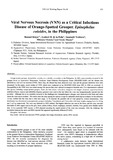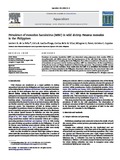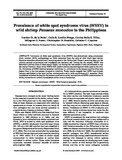| dc.contributor.author | Romana-Eguia, Maria Rowena R. | |
| dc.contributor.editor | Primavera, Jurgenne H. | |
| dc.contributor.editor | Quinitio, Emilia T. | |
| dc.contributor.editor | Eguia, Maria Rowena | |
| dc.date.accessioned | 2019-01-31T01:48:25Z | |
| dc.date.available | 2019-01-31T01:48:25Z | |
| dc.date.issued | 2006 | |
| dc.identifier.citation | Romana-Eguia, M. R. R. (2006). Application of DNA-based markers in stock enhancement programs. In J. H. Primavera, E. T. Quinitio, & M. R. R. Eguia (Eds.), Proceedings of the Regional Technical Consultation on Stock Enhancement for Threatened Species of International Concern, Iloilo City, Philippines, 13-15 July 2005 (pp. 7-15). Tigbauan, Iloilo, Philippines: Aquaculture Department, Southeast Asian Fisheries Development Center. | en |
| dc.identifier.isbn | 9789718511794 | |
| dc.identifier.uri | http://hdl.handle.net/10862/2929 | |
| dc.description.abstract | Aquaculture and fisheries management require tools for identifying individuals or groups of aquatic organisms for the purpose of monitoring performance (growth, survival and behavior) and stock structure. In aquaculture research, commercially important traits of tagged individuals are assessed to generate supportive data for selective breeding, genetic improvement and commercial-scale fish farming. Fisheries management employs identification systems for the evaluation of stock abundance, population dynamics and documentation of wild and hatchery-bred stocks. Stock structure analysis is useful in the planning and implementation of sound stock management and more importantly, in stock enhancement programs. Blankenship and Leber (1995) underscored the inclusion of tagging/marking strategies for released hatchery stocks in the guidelines for responsible marine stock enhancement. Identifying and keeping track of introduced stocks in release habitats allows an assessment of their adaptability in the wild (Allendorf et al., 1988) and the success of the reseeding and/or restocking effort. Although often used interchangeably, the terms ‘tags’ and ‘markers’ differ by definition. Tags are artificial or synthetic materials that are attached to the aquatic organism to allow individual or group identification while markers are traits or characters either applied or inherent to the organism (Thorsteinsson, 2002). Tags/markers are essential in evaluating resource distribution patterns, behavior, migration and movement of stocks, dynamics of exploited aquatic populations and evolutionary processes, all of which comprise baseline information for any stock management, enhancement and conservation program in aquaculture and fisheries (Allendorf et al 1988, Mulvey et al., 1998). | en |
| dc.language.iso | en | en |
| dc.publisher | Aquaculture Department, Southeast Asian Fisheries Development Center | en |
| dc.title | Application of DNA-based markers in stock enhancement programs | en |
| dc.type | Conference paper | en |
| dc.citation.spage | 7 | |
| dc.citation.epage | 15 | |
| dc.subject.asfa | DNA | en |
| dc.subject.asfa | dna barcoding | en |
| dc.subject.asfa | genetic markers | en |
| dc.subject.asfa | stock assessment | en |
| dc.subject.asfa | stocking (organisms) | en |
| dc.subject.asfa | stocks | en |
| dc.subject.asfa | aquaculture | en |
| dc.subject.asfa | tagging | en |
| dc.subject.asfa | tags | en |
| dc.subject.asfa | genetic techniques | en |
| dc.subject.asfa | depleted stocks | en |
| dc.subject.asfa | fishery management | en |
| dc.subject.asfa | seed collection | en |
| dc.subject.asfa | seeding (aquaculture) | en |
| dc.citation.conferenceTitle | Proceedings of the Regional Technical Consultation on Stock Enhancement for Threatened Species of International Concern, Iloilo City, Philippines, 13-15 July 2005 | en |



